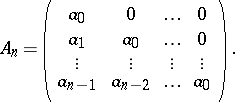Carathéodory interpolation
Let  be a polynomial of degree at most
be a polynomial of degree at most  . Let
. Let  be the Hardy space (cf. Hardy spaces) formed by the set of all analytic functions
be the Hardy space (cf. Hardy spaces) formed by the set of all analytic functions  in the open unit disc whose
in the open unit disc whose  -norm
-norm  is finite. One says that
is finite. One says that  is an interpolant of
is an interpolant of  if
if  is a function in
is a function in  and
and  are the first
are the first  Taylor coefficients of
Taylor coefficients of  for
for  , that is,
, that is,  for some
for some  in
in  (cf. also Taylor series).
(cf. also Taylor series).
The Carathéodory interpolation problem is to find the set of all interpolants  of
of  satisfying
satisfying  . Of course, this set can be empty. Let
. Of course, this set can be empty. Let  be the
be the  lower triangular Toeplitz matrix defined by
lower triangular Toeplitz matrix defined by
 |
Then there exists a solution of the Carathéodory interpolation problem if and only if  . Moreover, there exists a unique solution of the Carathéodory interpolation problem if and only if
. Moreover, there exists a unique solution of the Carathéodory interpolation problem if and only if  . In this case the unique interpolant
. In this case the unique interpolant  of
of  satisfying
satisfying  is a Blaschke product.
is a Blaschke product.
The Schur method for solving the Carathéodory interpolation problem [a1], [a2] is based on the Möbius transformation (cf. Fractional-linear mapping)  where
where  . By recursively unravelling this Möbius transformation, I. Schur discovered that
. By recursively unravelling this Möbius transformation, I. Schur discovered that  uniquely determines and is uniquely determined by
uniquely determines and is uniquely determined by  , where
, where  forms a sequence of complex numbers now referred to as the Schur numbers, or reflection coefficients, for
forms a sequence of complex numbers now referred to as the Schur numbers, or reflection coefficients, for  . The Schur algorithm is a computational procedure, discovered by Schur, which computes
. The Schur algorithm is a computational procedure, discovered by Schur, which computes  from
from  , or vice versa, in about
, or vice versa, in about  computations. Moreover,
computations. Moreover,  for all
for all  if and only if
if and only if  . In this case the set of all solutions
. In this case the set of all solutions  of the Carathéodory interpolation problem is given by
of the Carathéodory interpolation problem is given by
 |
where  is an arbitrary function in
is an arbitrary function in  satisfying
satisfying  . Furthermore,
. Furthermore,  if and only if
if and only if  for
for  and
and  for
for  . In this case
. In this case
 |
is the unique solution of the Carathéodory interpolation problem. If the reflection coefficients  do not satisfy any one of the previous conditions, then
do not satisfy any one of the previous conditions, then  and there is no solution of the Carathéodory interpolation problem; see [a4] for further details.
and there is no solution of the Carathéodory interpolation problem; see [a4] for further details.
The Schur numbers  are precisely the reflection coefficients which naturally occur in certain inverse scattering problems for layered media in geophysics. Therefore, the Schur algorithm plays an important role in geophysics and marine seismology, see [a3], [a4], [a5]. Finally, it has been noted that the Schur algorithm can also be used to obtain a Routh or Jury test for the open unit disc, that is, the Schur algorithm can be used to determine whether or not a polynomial
are precisely the reflection coefficients which naturally occur in certain inverse scattering problems for layered media in geophysics. Therefore, the Schur algorithm plays an important role in geophysics and marine seismology, see [a3], [a4], [a5]. Finally, it has been noted that the Schur algorithm can also be used to obtain a Routh or Jury test for the open unit disc, that is, the Schur algorithm can be used to determine whether or not a polynomial  has all its roots inside the open unit disc without computing the zeros of
has all its roots inside the open unit disc without computing the zeros of  ; see [a2], [a4].
; see [a2], [a4].
References
| [a1] | I. Schur, "On power series which are bounded in the interior of the unit circle" I. Gohberg (ed.) , Methods in Operator Theory and Signal Processing , Operator Theory: Advances and Applications , 18 (1986) pp. 31–59 (Original (in German): J. Reine Angew. Math. 147 (1917), 205–232) |
| [a2] | I. Schur, "On power series which are bounded in the interior of the unit circle. II" I. Gohberg (ed.) , Methods in Operator Theory and Signal Processing , Operator Theory: Advances and Applications , 18 (1986) pp. 68–88 (Original (in German): J. Reine Angew. Math. 184 (1918), 122–145) |
| [a3] | J.F. Claerbout, "Fundamentals of geophysical data processing" , McGraw-Hill (1976) |
| [a4] | C. Foias, A. Frazho, "The commutant lifting approach to interpolation problems" , Operator Theory: Advances and Applications , 44 , Birkhäuser (1990) |
| [a5] | E.A. Robinson, S. Treitel, "Geophysical signal analysis" , Prentice-Hall (1980) |
Carathéodory interpolation. Encyclopedia of Mathematics. URL: http://encyclopediaofmath.org/index.php?title=Carath%C3%A9odory_interpolation&oldid=23220